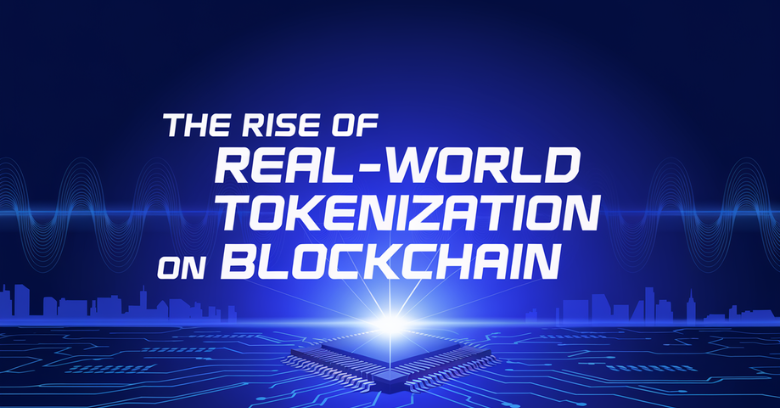What is Real-World Asset Tokenization?
Blockchain technology revolutionizes industries by enabling digital ownership, transparent transactions, and decentralized solutions. Among its most groundbreaking applications is real-world asset tokenization, which converts physical assets, such as real estate, art, and commodities, into digital tokens on a blockchain.
Tokenization bridges the gap between the tangible and digital worlds, allowing physical assets to be bought, sold, and traded securely and efficiently. As real-world asset tokenization gains momentum, it promises to redefine asset management, improve liquidity, and democratize access to previously inaccessible markets.
In this article, we’ll explore how tokenization is transforming industries, its benefits, challenges, and the future of this innovative blockchain application.
1. What is Real-World Asset Tokenization?
Real-world asset tokenization refers to the process of creating digital tokens on a blockchain that represent ownership or fractional ownership of physical assets. These tokens are unique, tamper-proof, and traceable, thanks to blockchain technology.
For instance, a real estate property worth $1 million can be tokenized into 1,000 tokens, each worth $1,000. Investors can purchase these tokens, gaining partial ownership of the property without the need for intermediaries.
2. How Tokenization Works
The process of real-world asset tokenization typically involves the following steps:
2.1 Asset Valuation and Structuring
The physical asset is evaluated, and its ownership structure is determined.
2.2 Token Creation
Smart contracts are used to create digital tokens that represent the asset or its fractions.
2.3 Asset Custody
A trusted custodian is responsible for securely holding the physical asset while the tokens circulate in the digital ecosystem.
2.4 Blockchain Integration
Tokens are issued on a blockchain, where their ownership and transaction history are recorded.
2.5 Secondary Market Trading
Token holders can trade their tokens on blockchain-based marketplaces, providing liquidity for traditionally illiquid assets.
3. Benefits of Real-World Asset Tokenization
3.1 Enhanced Liquidity
Traditionally illiquid assets, such as real estate or fine art, become easily tradable through tokenization. Fractional ownership allows smaller investors to participate, creating a liquid market.
3.2 Democratization of Investment
Tokenization lowers entry barriers, enabling individuals to invest in high-value assets previously accessible only to wealthy investors or institutions.
3.3 Improved Transparency and Security
Blockchain’s immutable ledger ensures that all transactions are transparent, traceable, and secure, reducing fraud and enhancing trust.
3.4 Reduced Costs and Intermediaries
Tokenization eliminates intermediaries like brokers and reduces transaction costs, making investment processes more efficient.
3.5 Global Accessibility
Investors worldwide can access tokenized assets, broadening the investor base and enabling cross-border transactions without complex legal frameworks.
4. Industries Leveraging Asset Tokenization
4.1 Real Estate
Tokenization has revolutionized real estate by enabling fractional ownership of properties. Platforms like Propy and RealT allow investors to purchase tokens representing property shares.
4.2 Art and Collectibles
Through tokenization, art and collectibles are becoming accessible to a broader audience. Companies like Maecenas tokenize high-value art pieces, enabling shared ownership.
4.3 Commodities
Gold, oil, and other commodities are being tokenized to improve liquidity and enable fractional investment. For example, Paxos offers tokenized gold backed by physical reserves.
4.4 Financial Instruments
Tokenized bonds, equities, and derivatives are transforming traditional finance by providing efficient, transparent trading mechanisms.
4.5 Gaming and Virtual Assets
Tokenization is also prominent in gaming, where virtual assets like in-game items and land in the metaverse are being tokenized and traded.
5. Challenges in Implementing Tokenization
While real-world asset tokenization offers immense potential, it is not without challenges:
5.1 Regulatory Hurdles
Regulatory frameworks for tokenized assets vary across jurisdictions, creating uncertainty for investors and issuers.
5.2 Legal Ownership
Ensuring that token holders have enforceable legal rights to the underlying asset remains a challenge.
5.3 Technology Barriers
Blockchain scalability and interoperability issues can hinder the widespread adoption of tokenized assets.
5.4 Market Volatility
The value of tokenized assets can be influenced by market speculation, leading to volatility.
5.5 Security Risks
While blockchain is secure, the surrounding infrastructure, such as wallets and exchanges, may be vulnerable to cyberattacks.
6. The Role of Regulation in Asset Tokenization
Regulatory clarity is essential for the success of real-world asset tokenization. Governments and financial institutions are working to establish frameworks that address:
- Ownership rights for token holders.
- Tax implications of tokenized assets.
- Compliance with anti-money laundering (AML) and know-your-customer (KYC) regulations.
Countries like Switzerland and Singapore are leading the way with progressive regulatory environments for tokenized assets.
7. Future Trends in Real-World Asset Tokenization
7.1 Increased Adoption by Institutional Investors
Institutional players are expected to drive the next wave of adoption, bringing credibility and liquidity to the tokenization market.
7.2 Integration with DeFi
Decentralized finance (DeFi) protocols will integrate tokenized assets, enabling lending, borrowing, and staking of real-world assets.
7.3 AI and Automation in Tokenization
AI-driven platforms will streamline asset valuation, token issuance, and compliance, making the process more efficient.
7.4 Expansion into New Asset Classes
Beyond real estate and art, tokenization will expand into unique assets like intellectual property, patents, and even carbon credits.
8. How Businesses Can Capitalize on Tokenization
8.1 Partner with Tokenization Platforms
Collaborate with established platforms to tokenize assets securely and efficiently.
8.2 Educate Stakeholders
Raise awareness among investors and stakeholders about the benefits and risks of tokenized assets.
8.3 Focus on Compliance
Work with legal experts to ensure adherence to local and international regulations.
8.4 Leverage Blockchain Interoperability
Adopt interoperable blockchain solutions to reach a wider market and enhance asset liquidity.
Wrapping It Up: The Future of Real-World Asset Tokenization
Real-world asset tokenization is revolutionizing the way we perceive and interact with physical assets. By integrating blockchain technology, tokenization enhances liquidity, democratizes access, and reduces costs, making asset ownership more inclusive and efficient.
As adoption grows and regulatory clarity improves, tokenization is poised to unlock trillions of dollars in previously untapped markets. For businesses and investors, embracing tokenization is not just an opportunity—it’s a necessity to thrive in the digital age.



